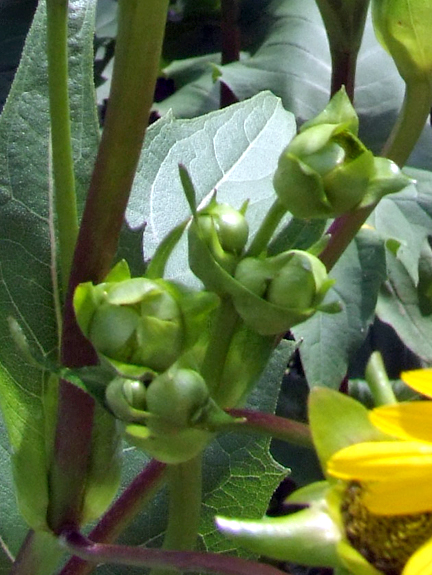
Perennials, Weeds > Silphium > Silphium perfoliatum > Silphium perfoliatum
Silphium perfoliatum
Cup Plant, Carpenter’s Weed, Cup Rosin Weed
Origin: Native to Missouri, the United States of America.
| Family |
| Asteraceae |
| Genus |
| Silphium |
| Species |
| perfoliatum |
| Category |
| Perennials, Weeds |
| USDA Hardiness Zone |
| 1a - 6a |
| Canadian Hardiness Zone |
| 0a - 5b |
| RHS Hardiness Zone |
| H7 |
| Temperature (°C) |
| -51 - (-21) |
| Temperature (°F) |
| -60 - (-5) |
| Height |
| 1 - 2.5 m |
| Spread |
| 30 - 90 cm |
Photographs
Description and Growing Information
Flowering Period
| General Description |
| Silphium perfoliatum is a sunflower-like herbaceous perennial with tough, erect stems yellow flowers. |
| Landscape |
| Good for a low-maintenance backdrop to other perennials in rain or naturalized gardens. Will attract birds and butterflies. Needs lots of room to grow, can be weedy. Good for moist locations near water. |
| Cultivation |
| Grow in full sun, in moist, rich soil. Tolerant of clay and wet soils as well as some drought once established. |
| Growth |
| Fast |
| Pests |
| No serious pests or diseases of note. |
| Habitat |
| Low woods and thickets, meadows, prairie stream or pond edges. |
| Leaf Description |
| Opposite, basally united in pairs and perfoliate to form a cup shape, broad at base, tapering to a point with coarse crenation (rounded teeth) and palmate venation (several primary veins diverging from a point). |
| Flower Description |
| Single, sunflower-like heads up to 7.5 cm in diameter with 20 - 40 long, narrow, bright yellow rays and darker yellow centres. |
| Texture Description |
| Coarse. |
| Propagation |
| By seed, will self-seed in ideal conditions. |
| Ethnobotanical Uses (Disclaimer) |
| The roots are diaphoretic (inducing perspiration), used to treat liver and spleen ailments, fevers, internal bruises, debility, ulcers, and as a general alterative restorative. Its gummy sap is a stimulant and antispasmodic. |

